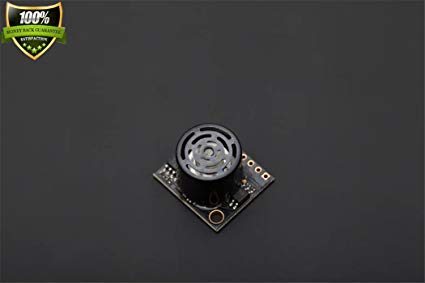- Make sure this fits by entering your model number.
- Operates from 2.5V-5.5V/42kHz Ultrasonic sensor measures distance to objects/RoHS compliant
- Read from all sensor outputs: Analog Voltage, RS232 or TTL Serial, and Pulse Width/Virtually no sensor dead zone, objects closer than 30 cm will typically range as 30 cm
- Resolution of 1 mm/Maximum range of 5000 mm (195 inches)/Tolerates outside noise sources/10Hz reading rate/Small, light weight module
- Designed for easy integration into your project or product/Operational Temperature from -15℃ to +65℃ (+5℉ to +149℉)/Real-time automatic calibration (voltage, humidity, ambient noise)
- Internal temperature compensation/Option external temperature compensation HR-MaxTemp/Firmware filtering for better noise tolerance and clutter rejection/Great starting point for users unsure of which sensor to use
The HRLV-MaxSonar-EZ products are high resolution ultrasonic sensors, that provide a component module solution that offers easy to use outputs, no sensor dead zone, calibrated beam patterns, stable range readings, low power demands, and a host of other features.
FEATURES
1mm Resolution
The HRLV-MaxSonar-EZ Sensors offer calibrated 1 mm accuracy of 0.1% at 1 meter.
Internal Temperature Compensation
The speed of sound in air increases about 0.6 meters per second, per degree centigrade. Because of this, each HRLV‑MaxSonar‑EZ is equipped with an internal temperature sensor which allows the sensor to apply a compensation for speed of sound changes.
With the internal temperature sensor, range readings immediately (within twenty seconds) after power up are the most accurate, and this is ideal for battery applications where the sensor is powered off most of the time. The self heating (15mW at 5V, or 8mW at 3.3V) will change the temperature of the sensor by 3 degrees C or so. (The amount of self heating is also slightly dependent upon user mounting). As such, self heating will cause the sensor to read the actual air temperature inaccurately.
External Temperature Sensor
With the HR‑MaxTemp connected to the HRLV‑MaxSonar‑EZ line of sensors, realtime automatic temperature compensation is available. The HR-MaxTemp allows the HRLV‑MaxSonar‑EZ sensor to monitor the changes to air temperature while ignoring self-heating.
Self-heating is an issue with internal temperature sensors, where the temperature increase is typically 2 to 5 degrees centigrade. If ignored this will cause a drift of the reported of up to 3%.
The HRLV‑MaxSonar‑EZ is designed to used alongside the HR‑MaxTemp temperature sensor. On power-up the HRLV‑MaxSonar‑EZ will automatically detect an attached temperature sensor and begin to apply temperature compensation for the speed of sound changes to all range outputs.

